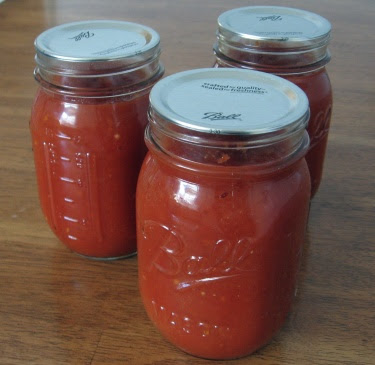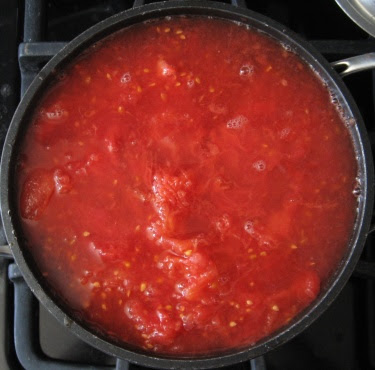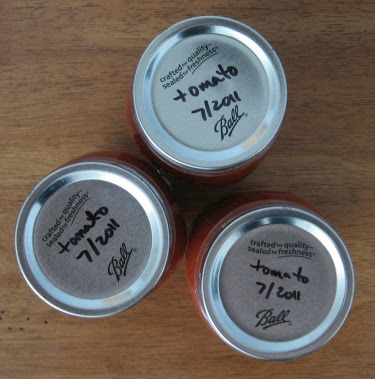
Look what we made!
My mom used to can massive amounts of produce. The basement shelves were permanently full of homemade apricot jam, brandied peaches, and pickled beets. (We never got any brandied peaches: boo! On the other hand, this all took place before I was 16.) I wasn't allowed to help with the canning, though. This isn't exactly surprising--no one wants their 10-year-old to get scalded with boiling sugar--but the upshot was that I didn't learn to can. I saw what happened, and absorbed the basic principles, but never got to practice with someone who knew what they were doing.
So this was my first excursion into canning.
If you read the
USDA guidelines or the
Ball Blue Book (which you really should if you plan to can), you get a boatload of explicit warnings as to safety: food acidity, water bath vs pressure canning, sterilization techniques, and, of course,
what to do if you ever even suspect that you have unwittingly cultivated a can full of botulism bacteria. The intimidation factor can get pretty high.
The thing is, as long as you follow all the safety guidelines, it's pretty difficult to go wrong. The preserving action itself is fairly easy, if a bit tedious. If you're canning tomatoes, you'll want to clear a full afternoon. But really, it's only a bit of prep and a lot of boiling. You can do that, right?
Canning tomato sauce
tomatoes (we used about 5 pounds, which made 3 pints of sauce; more is fine)
bottled lemon juice or citric acid
canning jars, new lids, and rings
a water bath canner or other pot large enough for your cans
canning tools: a wide-mouth funnel and jar lifter are the two crucial ones.
For my tomatoes, I followed
these guidelines. Since we have no pressure canner (and in fact have no canner at all--I boiled my jars in a tall pot with a pasta insert and a towel to ensure separation and water circulation), I needed to make a sauce with only tomatoes. This ensured that my finished result would be
acidic enough to process in a water bath. So I peeled and cored my tomatoes, put them all in a pot (squishing each by hand as I went), and boiled them down until they reduced by about half their volume. Since we like smooth tomato sauce, I pureed everything with a stick blender as well.
The boiling took a long time--probably about four hours--but that was at least partially because I don't have a massive selection of gigantic stockpots, and the biggest pot was already serving as the canner. So I had to use a regular 3-quart pot, which couldn't handle all the tomatoes at once. We still came perilously close to boiling over during the initial cooking. In conclusion, I need to start looking out for either a real canner or several massive pots with lids at Goodwill.

In the meantime, I prepped the jars. While
you don't need to sterilize tomato jars--you'll be boiling them for 35-40 minutes during the actual water bath canning process, which will provide plenty of sterilization--you do need to wash them and remove all hints of detergent. (I was under the impression that I needed the jars to be hot on packing, to reduce the risk of cracking, so I put mine on to boil anyway. So my jars were sterilized twice. Oh well.) I inspected my lids and put them on to simmer for a bit as well; this softens the sealing compound around the rims.
When everything was ready, I filled my jars, working one at a time. First, to acidulate the tomatoes enough for safe water bath canning, you need to
add bottled lemon juice or citric acid to the jar. The amount will vary depending on what you use. I was using pint jars, so I added a tablespoon of bottled lemon juice to each jar. Then, using a wide-mouth funnel to prevent any spills, ladle your sauce into your jar. Leave 1/4 inch of headspace at the top of each jar. Run a thin spatula or a chopstick around the inside of your jar, against the glass, to remove any air bubbles. Wipe off the lid of your jar, making sure it's dry. Then put on a hot lid and screw on a ring. The rings should be tightened to "finger tightness," which is to say, as tight as you can get them without any undue effort. You want the jars closed securely, but not screwed down so tightly that no air can escape. Repeat until you have filled all your jars. If you have any odd fraction of sauce left over, you can either freeze it or refrigerate and use within the next few days.
Now all you have to do is boil your jars of sauce. Lower the jars into your canner, fitting them into the rack securely. (If you're me, put them in the pasta insert and tuck a towel around them.) Add water to cover your jars by at least one inch, lid the canner, and put it on to boil. When the water reaches a full, rolling boil, start timing.
The boiling time is different for different sizes of jars and different altitudes. If you don't know your altitude, you can
find it with this tool. I used
this chart to determine that I needed to boil my pint jars for 35 minutes.
Keep your canner at a full boil for the entire time, checking occasionally to make sure your cans are still sufficiently covered. If you need more water, boil some in a teakettle before you add it. It's super important that you keep everything at a full boil for the entire duration! This will ensure that any botulism bacteria is good and dead. If your water ever goes below a boil, you need to bring it back up and restart your timer.
When the processing time is finished, take your jars out of the canner one by one, using a jar lifter so you don't burn yourself. Be sure to keep them vertical, as the sealing compound in the lids will still be soft and permeable. Put your cans on a double layer of towels or a cooling rack on your kitchen counter. As the jars cool down, you'll hear a series of pings; this means the jars are sealing correctly. My jars pinged all at once, practically as soon as I took them out of the canner, but the timing really depends.

Let the jars cool on the counter for 24 hours.
Test your jar seals and remove the rings before storing your jars. Label your jars; I used permanent marker to note the date and contents on the lid, but you can always get fluffy and design fancy label stickers if you so desire. Store your canned sauce somewhere dark and cool, like your kitchen cabinet or your basement.
Now sit down and congratulate yourself. Hooray! You have successfully canned tomato sauce! Now, if you're lucky and find a bunch of cheap tomatoes at the next farmer's market, you can do it all again next week.